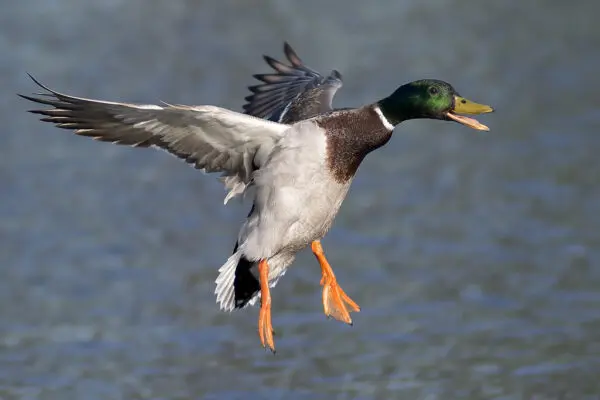In the vast tapestry of nature, the night holds secrets that are often hidden from plain sight. As the sun dips below the horizon and darkness cloaks the world, a different realm awakens. Among the creatures that thrive in this nocturnal domain, none are as mysterious and captivating as nocturnal birds. These avian beings, with their keen senses and enigmatic behaviors, navigate the nighttime skies with grace and precision.
From the haunting call of the owl echoing through the woods to the stealthy swoop of the nightjar as it hunts insects under the cover of darkness, each species of nocturnal bird brings its own unique charm to the night. In this blog post, we will delve into the fascinating world of these creatures of the night, exploring their adaptations, behaviors, and the vital roles they play in ecosystems around the globe.
List Of 20 Nocturnal Birds
Barred Owl

Image Source
- Scientific name: Strix varia
- Life span: up to 24 years in captivity
- Size: length of 16-25 inches, wingspan of 38-49 inches
- Weight: 1-2 lbs
- Origin: North America
The Barred Owl (Strix varia) is a medium to large-sized owl native to North America. Its distinctive features include a round face with dark eyes, a yellow beak, and a barred brown-and-white plumage that provides excellent camouflage in wooded habitats.
Barred Owls inhabit dense forests, preferring mixed woodlands near water sources. They are versatile and can adapt to various environments, including suburban areas.
Barred Owls are primarily nocturnal, meaning they are most active during the night. Their nocturnal behavior is attributed to their hunting habits, where they prey on small mammals like mice, squirrels, and rabbits, as well as birds. Their excellent night vision and keen hearing make them well-suited for hunting in low light conditions.
Kakapo

- Scientific name: Strigops habroptilus
- Lifespan: 40 – 80 years
- Size: 23 to 25 in
- Native to: New Zealand
- Beaks typically measure 1-2 inches (2.5–5 cm) long.
The Kakapo (Strigops habroptilus), also known as the night parrot or owl parrot, is a large, nocturnal, flightless parrot native to New Zealand. It is characterized by its moss-green feathers, owl-like face, and a relatively short, stout body.
Historically, the Kakapo inhabited both the North and South Islands of New Zealand, but due to habitat loss and introduced predators, it is now restricted to predator-free offshore islands.
The Kakapo is strictly nocturnal, being most active during the night. This behavior is thought to have evolved as a strategy to avoid diurnal predators. Kakapos feed on a variety of plant material, including leaves, fruits, and seeds, during the night.
Large-tailed Nightjar:

- Scientific Name: Caprimulgus macrurus
- Lifespan: Information not widely available
- Size: Approximately 25 cm (10 in) in length
- Origin: Southeast Asia
The Large-tailed Nightjar (Caprimulgus macrurus) is a nocturnal bird found in parts of Asia and Australia. It is known for its cryptic plumage, large eyes, and a distinctive long tail.
Large-tailed Nightjars inhabit a range of habitats, including open woodlands, grasslands, and scrublands. They are often found in areas with sparse vegetation, where they can easily forage for insects.
As the name suggests, the Large-tailed Nightjar is primarily active during the night. Its nocturnal habits are crucial for its feeding behavior, as it is an insectivore that catches flying insects in mid-air using its wide gape and specialized bristles around its mouth.
Night Parrot:

- Scientific Name: Pezoporus occidentalis
- Lifespan: Information not widely available
- Size: Approximately 23 cm (9 in) in length
- Origin: Australia
The Night Parrot (Pezoporus occidentalis) is a small, ground-dwelling parrot native to the arid interior of Australia. It is known for its elusive nature and secretive behavior.
Night Parrots inhabit spinifex grasslands and arid regions, where they seek refuge in the dense vegetation during the day.
The Night Parrot is predominantly nocturnal, emerging from its daytime hiding places to forage for seeds, grasses, and other vegetation during the night. Its nocturnal habits are believed to be a response to the extreme temperatures of its arid habitat, allowing it to avoid the heat of the day. The Night Parrot’s elusive nature has contributed to the mystery surrounding its existence, and it is considered one of the rarest and least-known bird species.
Tawny Frogmouth:

- Scientific name: Podargidae
- Lifespan: up to 14 years
- Size: 10 to 22 inches
- Native to: native to Australia
The Tawny Frogmouth (Podargus strigoides) is a species of bird native to Australia, often mistaken for an owl due to its nocturnal habits and appearance. It has a wide, flattened beak, large eyes, and mottled plumage that resembles tree bark, providing excellent camouflage.
Tawny Frogmouths are found in a variety of habitats, including forests, woodlands, and urban areas. They are well adapted to both native and introduced vegetation.
Tawny Frogmouths are primarily nocturnal, and their cryptic plumage helps them blend seamlessly with tree branches during the day. They are skilled hunters, feeding on insects and small vertebrates at night. Despite their owl-like appearance, they are more closely related to nightjars.
Stone Curlew:

- Scientific Name: Burhinus oedicnemus
- Lifespan: Up to 10 years in the wild
- Size: 38–46 cm (15–18 in) in length
- Origin: Europe, Asia, and Africa
The Stone Curlew, also known as the Eurasian Thick-knee (Burhinus oedicnemus), is a medium to large-sized bird with a distinctive appearance. It has a robust build, large eyes, and cryptic plumage that aids in camouflage.
Curlews inhabit open landscapes, including grasslands, heathlands, and coastal areas. They are known for their preference for sparsely vegetated habitats.
Stone Curlews are primarily nocturnal, displaying more activity during the night. They are ground-dwelling birds and use their nocturnal habits as a strategy for foraging. Their diet consists mainly of insects, small mammals, and other invertebrates that they locate using their keen eyesight.
Mockingbird:

- Scientific name: Mimus polyglottos
- Lifespan: about 8 to 10 years
- Wingspan: 12 to 14 inches
- Native to the United States and in Canada and Mexico
The Mockingbird is a group of New World passerine birds known for their exceptional vocal abilities and mimicry. One well-known species is the Northern Mockingbird (Mimus polyglottos), found in North America, which has grayish plumage and a long tail.
Mockingbirds are adaptable and can be found in a variety of habitats, including urban areas, parks, and scrublands.
Mockingbirds are diurnal, meaning they are primarily active during the day. They are known for their elaborate songs, which they use to establish territory and attract mates. While not nocturnal, they may sing at night during the breeding season.
Australian Owlet-nightjar:

- Scientific Name: Aegotheles cristatus
- Lifespan: Information not widely available
- Size: Approximately 22 cm (9 in) in length
- Origin: Australia, Tasmania, and New Guinea
The Australian Owlet-nightjar (Aegotheles cristatus) is a small nocturnal bird native to Australia. Despite its name, it is not closely related to owls but belongs to the nightjar family. It has a compact build, large eyes, and soft plumage.
Australian Owlet-nightjars inhabit a variety of forested habitats, including eucalyptus forests and woodlands.
True to its name, the Australian Owlet-nightjar is strictly nocturnal. It hunts for insects during the night using its excellent night vision and silent flight. During the day, it roosts in tree hollows, where its cryptic plumage provides effective camouflage.
Little Penguin:

- Scientific Name: Eudyptula minor
- Lifespan: Up to 6 years in the wild
- Size: 30–33 cm (12–13 in) in height
- Origin: Australia and New Zealand
The Little Penguin (Eudyptula minor), also known as the Blue Penguin or Fairy Penguin, is the smallest species of penguin. It has a distinctive bluish-gray plumage, white underparts, and a small stature.
Little Penguins are found along the coastlines of southern Australia and New Zealand, as well as some nearby islands. They often nest in burrows or under vegetation for protection.
Little Penguins are primarily nocturnal, returning to their nests on land after dusk. They spend the day at sea, hunting for small fish and squid. At night, they come ashore in groups, navigating their way to their nests to avoid diurnal predators.
Long-eared Owl:

- Scientific Name: Asio otus
- Lifespan: Up to 10 years in the wild
- Size: 35–37 cm (14–15 in) in length
- Origin: Europe, Asia, and North America
The Long-eared Owl (Asio otus) is a medium-sized owl characterized by long tufts of feathers (ear tufts) on its head. It has a mottled brownish plumage that provides effective camouflage in its woodland habitats.
Long-eared Owls are found in a variety of wooded habitats, including coniferous and deciduous forests. They often roost in trees during the day.
Long-eared Owls are primarily nocturnal hunters, preying on small mammals like mice and voles. They are known for their stealthy flight and keen hearing, which helps them locate prey in low light conditions. During the day, they are typically inactive, roosting in concealed locations.
Ashy Storm-petrel:

- Scientific Name: Oceanodroma homochroa
- Lifespan: Information not widely available
- Size: Approximately 30 cm (12 in) in length
- Origin: Pacific Ocean
The Ashy Storm-petrel (Oceanodroma homochroa) is a small seabird with ashy-gray plumage and a slightly forked tail. It has a distinctive and agile flight, often gliding low over the ocean surface.
Ashy storm petrels breed on islands along the west coast of North America and spend much of their time at sea, foraging for small fish and invertebrates.
Ashy storm petrels are known for their nocturnal habits. They feed primarily at night, using their keen eyesight to locate prey on the water’s surface. During the breeding season, they return to their nesting colonies under the cover of darkness.
Eastern Whip-poor-will:

- Scientific name: Antrostomus vociferus
- Lifespan: Typically 4-6 years
- Size: Medium-sized; around 9-10 inches (23-25 cm) in length, wingspan of 16-18 inches (41-46 cm)
- Origin: Native to eastern North America, often found in deciduous forests and open woodlands.
The Whip-poor-will (Antrostomus vociferus) is a medium-sized nocturnal bird known for its distinctive and repetitive call, which sounds like “whip-poor-will.” It has a cryptic plumage with mottled patterns.
Whip-poor-wills are found in a variety of wooded habitats, including deciduous and mixed forests. They prefer areas with a mix of open spaces and trees.
Whip-poor-wills are strictly nocturnal and are most active during the night. They feed on moths, beetles, and other nocturnal insects, capturing prey with their wide gape. During the day, they roost on the ground, relying on their camouflage to avoid detection.
Kiwi

- Scientific name: Apteryx
- Lifespan: between 25 and 50 years
- Size: 14 to 18 inches
- Native to: New Zealand
- Beak length on average is 6 inches (15 cm)
The Kiwi is a flightless, nocturnal bird native to New Zealand, belonging to the ratite group. Kiwis have a distinctive appearance, featuring a long, slender bill, small wings, and coarse, brownish plumage.
Kiwis inhabit a range of environments, from native forests to scrublands and grasslands. They are ground-dwelling birds and are known for their strong sense of smell, used for locating invertebrates in the soil.
Kiwis are primarily nocturnal, foraging for food such as insects, worms, and fruit during the night. Their nocturnal habits are thought to be an adaptation to avoid diurnal predators. Kiwis are also known for their distinctive, haunting calls that echo through the forest at night.
Great Eared Nightjar:

- Scientific Name: Lyncornis macrotis
- Lifespan: Information not widely available
- Size: Approximately 30–40 cm (12–16 in) in length
- Origin: Southeast Asia
The Great Eared Nightjar (Lyncornis macrotis) is a large, nocturnal bird found in parts of Southeast Asia. It is known for its striking appearance, with large ear tufts, cryptic plumage, and a wide gape.
Great-eared Nightjars inhabit forests, woodlands, and open areas with adequate ground cover. They are well-camouflaged against the forest floor.
True to their name, Great Eared Nightjars are primarily nocturnal. They are expert fliers and use their large eyes to hunt for flying insects in the dark. During the day, they roost on the ground, relying on their camouflage to remain hidden.
Nightingale:

- Scientific Name: Luscinia megarhynchos
- Lifespan: Up to 2 years in the wild
- Size: 15–16.5 cm (6–6.5 in) in length
- Origin: Europe, Asia, and Africa
The Nightingale (Luscinia megarhynchos) is a small, migratory songbird known for its powerful and melodious song. It has a plain brown plumage with a slightly buff-colored underside.
Nightingales breed in Europe, Asia, and North Africa, favoring deciduous woodlands, thickets, and shrubby areas. They are known for their secretive behavior, often staying hidden in dense vegetation.
Nightingales are primarily diurnal, meaning they are active during the day. They are renowned for their elaborate and beautiful songs, which they use for territory establishment and attracting mates. While primarily diurnal, their singing activity can extend into the early night during the breeding season.
Black-crowned Night Heron:

- Scientific Name: Nycticorax nycticorax
- Lifespan: Up to 20 years in the wild
- Size: 58–65 cm (23–26 in) in length
- Origin: Worldwide distribution
The Black-crowned Night Heron (Nycticorax nycticorax) is a medium-sized heron with a stocky build, short legs, and distinctive black cap on its head. Its plumage is mostly gray and black.
Black-crowned Night Herons are found in a variety of wetland habitats, including marshes, swamps, and the edges of lakes and rivers. They are often associated with both freshwater and saltwater environments.
Despite the name, Black-crowned Night Herons are crepuscular, meaning they are most active during dawn and dusk. They also exhibit nocturnal feeding behaviors, hunting for fish, crustaceans, and other aquatic prey during the night. Their nocturnal habits are advantageous for exploiting prey that is more active during low-light conditions.
Potoo:

- Scientific Name: Nyctibius
- Lifespan: Information not widely available
- Size: Varies by species
- Origin: Central and South America
Potoos are nocturnal and crepuscular birds found in Central and South America. They are known for their cryptic plumage, large eyes, and unique appearance with a large head and a wide, gaping mouth.
Potoos inhabit tropical forests, often roosting on branches where their camouflage allows them to blend seamlessly with the tree bark.
Potoos are strictly nocturnal, remaining inactive during the day. They hunt for insects, such as moths and beetles, during the night by sitting quietly on a perch and relying on their excellent night vision to detect prey.
Corncrake:

- Scientific Name: Crex crex
- Lifespan: Up to 5 years in the wild
- Size: 26–30 cm (10–12 in) in length
- Origin: Europe and Asia
The Corncrake (Crex crex) is a medium-sized bird belonging to the rail family. It has a cryptic plumage with brown and buff markings, and it is known for its distinctive raspy call.
Corncrakes breed in grasslands, meadows, and farmlands with tall vegetation. They are known for their secretive behavior, often hiding in dense vegetation.
Corncrakes are primarily crepuscular and nocturnal, meaning they are most active during the dawn and dusk hours and throughout the night. Their loud, repetitive call is a characteristic sound of summer nights in certain regions.
Indian Nightjar:

- Scientific Name: Caprimulgus asiaticus
- Lifespan: Information not widely available
- Size: Approximately 25 cm (10 in) in length
- Origin: Indian subcontinent
The Indian Nightjar (Caprimulgus asiaticus) is a species of nightjar found in South Asia. It has a mottled brown plumage, a cryptic pattern that helps it blend with its surroundings.
Indian Nightjars are found in a variety of habitats, including grasslands, open woodlands, and scrublands. They are often seen resting on the ground during the day.
Indian Nightjars are strictly nocturnal, becoming active at dusk to hunt for insects such as moths and beetles. Their flight is characterized by a buoyant and erratic pattern as they catch prey in mid-air using their wide gape.
Common Nighthawk

- Scientific name: Chordeiles minor
- Lifespan: 4 to 5 years
- Wingspan: 23 inches
- Native to: Iceland, Greenland, the Azores, the Faroe Islands, and multiple times on the British Isles
The Common Nighthawk (Chordeiles minor) is a medium-sized, nocturnal bird with distinctive pointed wings and a cryptic plumage that provides effective camouflage.
Common Nighthawks are found in a variety of open habitats, including urban areas, grasslands, and deserts. They are often associated with areas where insects are abundant.
Despite the name, Common Nighthawks are crepuscular and nocturnal. They are known for their aerial displays during the evening, where they feed on flying insects. Their flight is characterized by agile maneuvers as they catch insects with their wide mouths.
Final Thoughts on Nocturnal Birds
In the quiet hours of the night, when most of the world slumbers, the nocturnal birds take flight, weaving their way through the darkness with unmatched skill and grace. Their presence reminds us of the complexity and beauty of the natural world, and the importance of preserving habitats where these magnificent creatures can thrive. As we gaze into the starlit sky, let us not forget the silent watchers that keep vigil through the night, enriching our lives with their mysterious allure. May we continue to marvel at the wonders of the nocturnal realm and strive to protect it for generations to come.







One thought on “20 Nocturnal Birds [Images + IDs]”